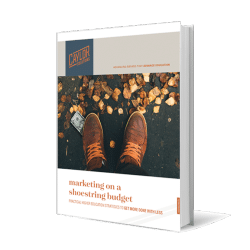Enrollment as a Turnaround Strategy: Leading a Proactive Recovery in Higher Ed
How Bethany College used enrollment as a turnaround strategy to overcome a $5M crisis—shifting from crisis management to mission-driven growth.
Marketing Strategies
Loan Repayment Assistance Programs, or LRAP’s, are another way schools can help students fight mounting education debt.
For years, we’ve helped colleges and universities with their messaging around tuition costs to help students and their families to see it more as an investment.
But a part of the messaging I recommend for costs is to reinforce the idea that the student is not alone – that you’ve got people on campus to help them with their FAFSA and find scholarships that fit them.
However, there is another way to help students financially – a Loan Repayment Assistance Program.
To talk about this, we spoke to Peter Samuelson, President at Ardeo Education Solutions, to explain what LRAP’s are, how they’re used, and how higher ed institutions benefit from them.
Peter came across the idea for LRAP’s from his own personal experience as a law student.
Like a lot of students, his academic pursuits were limited by his finances.
I was coming out of Greenville College down near St. Louis, heading to law school, and wanted to go to Yale Law School but couldn’t afford it. So I put in my deposit to go to University of Chicago Law School.
But then I discovered that Yale had this great program. They call it a “Career Options Assistance Program.” But every law school who copies them calls it a “Loan Repayment Assistance Program.”
The promise was “Come here, borrow a ton of money, pay us that borrowed money. And when you graduate, if your income is low, we’ll make your loan payments for you.” So, just a great program that said, “Yeah, I can go to law school, I can do public interest work when I graduate, and I’m not going to be burdened by a load of debt, because I can go do anything I want afterwards.”
That gave me the freedom to go to Yale instead of Chicago. I had a great experience [at Yale]. I used the program for a year afterwards to do human rights work in Sudan and in Hong Kong.
[The LRAP] really affected where I went to school, and how I started my career. I ended up on Wall Street, paid off the loans like most people do, which was great, but was just delighted to have that freedom to go anywhere.
Although Peter wanted to go to Yale from the beginning, it was the Loan Repayment Assistance Program that eventually decided for him where he would go.
That’s the case for so many students who want to go to your school!
An LRAP could be a way to help them make that critical decision to enroll at your institution rather than looking for the cheaper option.
But could a smaller college or university benefit from this kind of program without going broke?
After paying off his law school debt with the help of the LRAP, Peter returned to his roots in Kansas.
Here’s where he saw the potential for this same program at a smaller educational institution.
A few years later, I was looking to join the board of a college where my mom taught in McPherson, Kansas, the home of Central Christian College. It’s a small little school, totally different experience from Yale, totally different student body.
But it really had the same enrollment problem; they were admitting lots of students – doing all that marketing work to bring the students in, bring in the applications, and admit the students – and then 75% of students who were admitted said, “No, we can’t afford it, we’re going somewhere else.”
Obviously, students have lots of reasons to go somewhere else. But you know, the dominant reason to not attend after being admitted was, “We just don’t want to borrow the money.”
So I thought we needed the same program Yale has. Let’s tell the students, “We’re sure you’re making a good economic investment. We’re confident you’re going to get a good job.”
That’s true at most colleges – 80-90% of graduates do get good jobs. But there is that bottom group of students at 10 or 20% at every college every year who struggle to get a job. They come out with student loans. That burden really hurts.
Let’s give students the comfort and the confidence they need to come here and matriculate and get the value of this education.
Loan Repayment Assistance Programs solve a real-world problem.
They also show students how confident you are in your academic offering and in the success of your students.
LRAP’s have tremendous potential to help you boost enrollment by making your educational offering financially possible.
When you market your LRAP, you’re telling students that they’re not alone, that they can be sure you’ll still be with them along the way as they start out their careers.
Especially if you’re hoping to graduate essential workforce members who may not earn high incomes (think teachers, nonprofit leaders, or ministers), I highly recommend that you listen to the rest of our conversation with Peter.
Like all of our blog post reviews of The Higher Ed Marketer podcasts, there’s so much more to learn in the podcasts themselves.
Listen to our interview with Peter Samuelson to get even more insights into:
Set yourself free from your shrinking marketing budget with my popular ebook Marketing on a Shoestring Budget! This ebook is jammed with practical ways to produce high-quality marketing on the cheap.
Inside, I’ll show you proven marketing tactics like…
No hype. No pie in the sky. Just real solutions for getting the job done with the budget you’ve got.
Featured image via ardeoeducation.org
Subscribe to The Higher Ed Marketer podcast today!